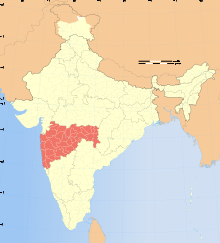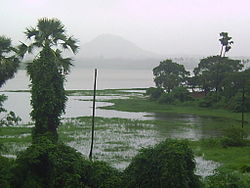- Maharashtra floods of 2005
-
2005 Mumbai Floods Date of Occurrence 26 July 2005 Place Mumbai, Maharashtra, India Deaths 1094[1] The 2005 Maharashtra floods refers to the flooding of many parts of the Indian state of Maharashtra including large areas of the metropolis Mumbai, a city located on the coast of the Arabian Sea, on the western coast of India, in which at least 5,000 people died. It occurred just one month after the June 2005 Gujarat floods. The term 26 July, now is, in context always used for the day when the city of Mumbai came to a standstill.
Large numbers of people were stranded on the road, lost their homes, and many walked for long distances back home from work that evening. The floods were caused by the eighth heaviest ever recorded 24-hour rainfall figure of 994 mm (39.1 inches) which lashed the metropolis on 26 July 2005, and intermittently continued for the next day. 644 mm (25.4 inches) was received within the 12-hour period between 8am and 8pm. Torrential rainfall continued for the next week. The highest 24-hour period in India was 1,168 mm (46.0 inches) in Aminidivi in the Union Territory of Lakshadweep on 6 May 2004 although some reports suggest that it was a new Indian record. The previous record high rainfall in a 24-hour period for Mumbai was 575 mm (22.6 inches) in 1974.
Other places to be severely affected were Raigad, Chiplun, Khed, Ratnagiri and Kalyan in Maharashtra and the southern state of Goa.
The rains slackened between the 28 July and 30 July but picked up in intensity on 31 July. The Maharashtra state government declared 27 July and 28 July as a state holiday for the affected regions. The government also ordered all schools in the affected areas to close on 1 August and 2 August. Mumbai Police commissioner Anami Narayan Roy requested all residents to stay indoors as far as possible on 31 July after heavy rains disrupted the city once again, grounding all flights for the day.
Contents
Overview
Thousands of school children were stranded due to flooding and could not reach home for up to 24 hours. The following two days were declared as school and college holidays by the state government. The city region and the suburbs that make up the metropolis of Mumbai received 994 mm (39.1 inches).
The rains also impacted the state of Goa and some parts of western Maharashtra on 25 July. Adding to the chaos was the lack of public information. Radio stations and many television stations did not receive any weather warnings or alerts by the civic agencies. The Met department blamed it on the lack of sophisticated weather radars which would have given a 3 hour prior warning which came due to high tides.
Threat to public health
The rain water caused the sewage system to overflow and all water lines were contaminated. The Government ordered all housing societies to add chlorine to their water tanks while they decontaminate the water supply.
Thousands of animal carcasses floated in the flood waters, raising concerns about the possibility of disease.
Reports in the media warned of the threat of waterborne diseases, and hospitals and health centers geared up to distribute free medicines to check any outbreak.
Topography
India's western coast receives high rainfall due to the presence of the Western Ghats which lie at about 50 km (31 mi) from the coast. The hill range runs parallel to the Indian coast at an average altitude of 1,200 metres (3,900 ft). Rain bearing clouds generally deposit much of their moisture through orographic rainfall along India's western coast which lies on the windward side of the hills.
Financial effect
The financial cost of floods was unprecedented and these floods caused a stoppage of entire commercial, trading, and industrial activity for days. Preliminary indications indicate that the floods caused a direct loss of about Rs. 450 crores (€80 million or US$100 million). The financial impact of the floods were manifested in a variety of ways:
- The banking transactions across the counters were adversely affected and many branches and commercial establishments were unable to function from late evening of 26 July 2005. The state government declared 27 and 28 July as public holidays. ATM networks of several banks, which included the State Bank of India, the nation's largest national bank; ICICI Bank, HDFC Bank, and several foreign banks like Citibank and HSBC, stopped functioning from the afternoon of 26 July 2005 at all the centers of Mumbai. ATM transactions could not be carried out in several parts of India on 26 July or 27 July due to failure of the connectivity with their central systems located in Mumbai.
- The Bombay Stock Exchange and the National Stock Exchange of India, the premier stock exchanges of India could function only partially. As most of the trading are eTrading, trading terminals of the brokerage houses across the country remained largely inoperative. Ironically, in partial trading, the Sensex, India's most tracked equity index closed at an all time high of 7605.03 on 27 July 2005. The Exchanges, however, remained closed for the following day.
Effect on Mumbai's links to the rest of the world
- For the first time ever, Mumbai's domestic and international airports (including Chatrapati Shivaji International Airport, Sahar and Juhu aerodrome) were shut for more than 30 hours due to heavy flooding of the runways and extremely poor visibility. Over 700 flights were cancelled or delayed. The airports reopened on the morning of 28 July 2005. Rediff. Within 24 hours of the airports becoming operational, there were 185 departures and 184 arrivals, including international flights. Again from early morning of 31 July, with increase in water logging of the runways and different parts of Mumbai, most of the flights were indefinitely cancelled.
- Rail links were disrupted, and reports on late evening of 30 July indicated cancellation of several long distance trains up to 6 August, 2005.
- The Mumbai-Pune Expressway, which witnessed a number of landslides, was closed the first time ever in its history, for 24 hours.
- According to the Hindustan Times, an unprecedented 5 million mobile and 2.3 million MTNL landline users were hit for over four hours.
- According to the .in registrar (personal communication), the .in DNS servers in Mumbai had to be reconfigured because the servers were not operational.
- Transport stats
- 52 local trains damaged
- 37,000 autorickshaws spoilt
- 4,000 taxis
- 900 BEST buses damaged
- 10,000 trucks and tempos grounded
Factors aggravating the disaster in Mumbai
Antiquated drainage system
The present storm-water drainage system in Mumbai was put in place in the early 20th century and is capable of carrying only 25 millimetres of water per hour which was extremely inadequate on a day when 993 mm of rain fell in the city. The drainage system is also clogged at several places.
Only 3 'outfalls' (ways out to the sea) are equipped with floodgates whereas the remaining 102 open directly into the sea. As a result, there is no way to stop the seawater from rushing into the drainage system during high tide.
In 1990, an ambitious plan was drawn to overhaul the city's storm water drainage system which had never been reviewed in over 50 years. A project costing approximately 600 crore rupees was proposed by UK based consultants hired by the Brihanmumbai Municipal Corporation to study the matter. Implementation of the project would have ensured that rainwater did not flood the streets of Mumbai. The project was planned to have completed by 2002 and aimed to enhance the drainage system through larger diameter storm water drains and pipes, using pumps wherever necessary and removing encroachments. The project, if implemented would have doubled the storm water carrying capacity to 50 mm per hour.
The BMC committee had rejected the proposed project on the grounds that it was "too costly". These were few of the drawbacks due to which the city suffered so gravely.
Uncontrolled, unplanned development in Northern Suburbs
Unlike South Mumbai, development in northern suburbs of Mumbai is haphazard and buildings are constructed without proper planning. The drainage plans in northern suburbs is chalked out as and when required in a particular area and not from an overall point of view.
The Environment Ministry of the Government of India was informed in the early 1990s that sanctioning the Bandra-Kurla complex (a commercial complex in northern Mumbai) was leading to disaster. No environment clearance is mandatory for large urban construction projects in northern Mumbai. Officials in the environment ministry claimed that it was not practical to impose new guidelines with retrospective effect "as there are millions of buildings".
Destruction of mangrove ecosystems
Mangrove ecosystems which exist along the Mithi River and Mahim Creek are being destroyed and replaced with construction. Hundreds of acres of swamps in Mahim creek have been reclaimed and put to use for construction by builders. These ecosystems serve as a buffer between land and sea. It is estimated that Mumbai has lost about 40% of its mangroves between 1995 and 2005, some to builders and some to encroachment (slums). Sewage and garbage dumps have also destroyed mangroves. The Bandra-Kurla complex in particular was created by replacing such swamps. The most acclaimed Mindspace CBD (INORBIT MALL) in Goregaon & Malad has been built by destroying a large patch of mangroves in Maharashtra.
In popular culture
The 2005 flooding disaster was featured in a National Geographic Documentary. Also there are two full length commercial Hindi feature films made and released on this unfortunate incident. The first movie was "26 July at Barista" that released in 2008, while the other movie on the same subject was released in November 2009 with the title "Tum Mile" and did not do very well at the box-office.
References
- BBC News
- BBC Updates
- CNN News
- CNN Updates
- CNN News
- Mumbai Help A blog dedicated to disseminate information on emergency services, helplines, infolines, relief/rehab organizations and their activities etc.
- Cloudburst Mumbai A blog dedicated for news, links and personal stories related to this tragedy.
- Beware and Prepare for in Mumbai May,June 2009 A blog where possible flood dates are given.
External links
- Photos of the disaster from Yahoo! News
- Helpline Numbers A list of Helpline Numbersheats
Categories:- 2005 natural disasters
- Floods in India
- History of Mumbai
- 2005 in India
Wikimedia Foundation. 2010.



